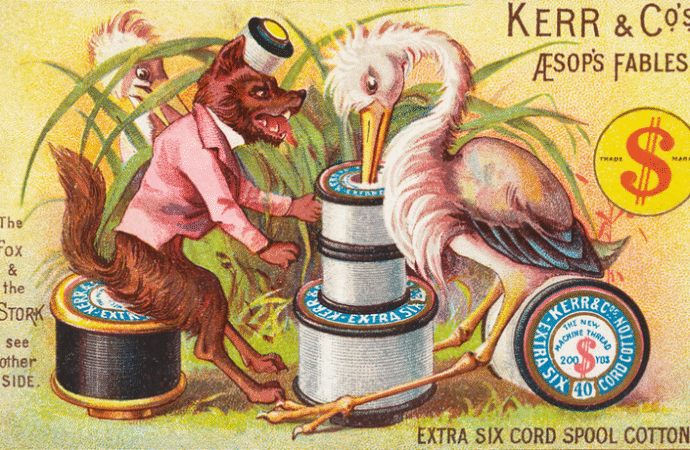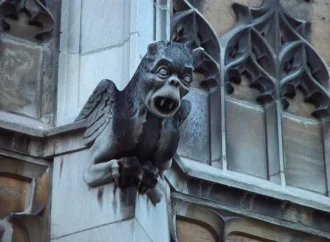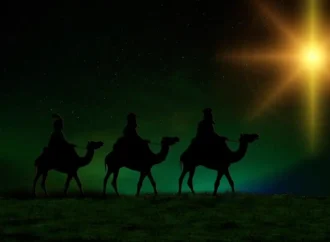Milon Townsend has worked in glass his entire adult life, turning out everything from jewelry to beautiful figurines over the last 50 years, devoting part of his time to sharing his knowledge with others. His work has appeared in museums and galleries, and he’s made hundreds of appearances selling his wares or teaching his craft to others around the country, often accompanied by his wife.
During the 2020 Covid lockdowns, Townsend looked for a serious project to bring him some artistic joy and give the opportunity to brighten the dull gray days of that year for others. Consequently, he created 50 glass sculptures, one a week, all of them based on Aesop’s fables. He weekly posted photographs of this statuary on multiple online platforms to bring pleasure and hope to others. In return, as he wrote in his recently released book, “the feedback and growing audience nourished my artistic soul.”
“Aesop’s Fables – Illustrated in Glass” features over a hundred photographs of Townsend’s glasswork along with 50 of Aesop’s tales and their moral lessons, all taken from an old translation by George Flyer Townsend. Townsend found a copy of his namesake’s book in some boxes he unpacked early in the pandemic, and though he didn’t know whether the author was a distant relative, it was this book which galvanized his project.
And so, by beautifying the fables with his art, the glassmaker has spotlighted a literary classic whose stories and proverbs are just as fresh and pertinent to the 21st century as they were to an audience 2,700 years ago.
Parents, teachers, and other adults who read some of these fables aloud to children will notice, as I did when sharing some of these with a grandson, that the morals accompanying the fables still function as a map and compass for us today. Here, for example, is one of George Townsend’s renditions from the Greek:
The Pig, Sheep, and the Goat
A young Pig was shut up in a pen with a Goat and a Sheep. On one occasion when the shepherd laid hold of him, he grunted and squeaked and resisted violently.
The Sheep and the Goat complained of his distressing cries, saying, “He often handles us, and we do not cry out.”
To this the Pig replied, “Your handling and mine are very different things. He catches you only for your wool, or your milk, but he lays hold of me for my very life.”
It is easy to be brave when there is no danger.
Here is another that sums up much of what passes for political debate these days in our public square and on social media:
The Two Dogs and The Skunk
Two dogs were passing the time of day with a Skunk. One Dog said, “This is a beautiful black Skunk with white stripes.”
The second Dog replied, “No, my friend, this is clearly a white Skunk with black stripes.”
The first Dog objected, “It is black with white.”
The second contradicted him, “White, with black!”
“No, it isn’t!”
“Yes, it is!”
The argument quickly devolved into barking. The Skunk shook his head and turned, sprayed them, and left.
Arguing over opinion changes no one’s mind and leaves a bad smell.
The first edition of Aesop appeared in English in 1483 and eventually became a staple in the moral education of the young. Even today, many people understand when others allude to “a fox and grapes” take on disappointment or “an ant and the grasshopper” approach to a savings account.
Abraham Lincoln was a man who learned his Aesop and lived by the old Greek’s moral code. He knew his Bible and Shakespeare, but Aesop was his first literary love. Short of books in his impoverished youth, he repeatedly delved into the fables, memorizing many of them, making mention of them throughout his life in conversations and speeches. As a writer at the Daily Stoic puts it, Aesop “became a lens through which he came to understand human nature….”
We hear a good deal these days about using children’s literature – fairy and folk tales, nursery rhymes and poems, and stories of heroes – as a vehicle for teaching character to children. Whether we use Milon Townsend’s lovely version or some other collection, we should include in that mix the fables of the great-great-granddaddy of Western culture and morality.
—
The republication of this article is made possible by The Fred & Rheta Skelton Center for Cultural Renewal.
Image Credit: Flickr-Boston Public Library, CC BY 2.0
29 comments















29 Comments
Repavotdilit
July 17, 2025, 2:25 pmI’m making $23000 to $29000 a month working part time. I kept hearing other people tell me how much money they ws can make online so I decided to look into it. Well, it was all true and has totally changed my life. First month i received $24758 just working on the laptop for 3 hours per day.
This is what I do…………www.get.money63.com
REPLYNorrisAHolmes@Repavotdilit
July 18, 2025, 5:30 amGᴏᴏɢʟᴇ ʜᴀꜱ ʙᴇᴇɴ ᴀɴ ɪɴᴄʀᴇᴅɪʙʟᴇ ᴏᴘᴘᴏʀᴛᴜɴɪᴛʏ! ᴇᴀʀɴ 𝟣𝟪𝟢𝟢+ ʙᴜᴄᴋꜱ ᴡᴇᴇᴋʟʏ ꜰʀᴏᴍ ʜᴏᴍᴇ! ᴀ ꜰᴇᴡ ᴍᴏɴᴛʜꜱ ᴀɢᴏ, ɪ ᴡᴀꜱ ꜱᴛᴜᴄᴋ ɪɴ ᴀ ʀᴏᴜᴛɪɴᴇ, ʙᴀʀᴇʟʏ ᴍᴀᴋɪɴɢ ᴇɴᴅꜱ ᴍᴇᴇᴛ. ɴᴏᴡ, ɪ ᴇᴀʀɴ 𝟤𝟢𝟧+ ᴀ ᴅᴀʏ ᴡᴏʀᴋɪɴɢ ꜰʀᴏᴍ ʜᴏᴍᴇ ᴡɪᴛʜ ᴄᴏᴍᴘʟᴇᴛᴇ ꜰʟᴇxɪʙɪʟɪᴛʏ! ɴᴏ ᴇxᴘᴇʀɪᴇɴᴄᴇ? ɴᴏ ᴘʀᴏʙʟᴇᴍ.
REPLYᴊᴏɪɴ ɴᴏᴡ➤➤ http://www.get.money63.com
illiana@NorrisAHolmes
July 18, 2025, 9:30 amI'am made $84, 8254 so far this year working online and I'm a full time student. Im using an online business opportunity I heard about and I'AM made such great money. It's really user friendly and I'm just so happy that I found out about it. Heres what I do,.for more information simply open this link thank you….
COPY HERE→→→→→Www.Join.Payathome9.com
REPLYJoelDarvall@NorrisAHolmes
July 19, 2025, 11:46 amEverybody can earn 220$/h + daily 1K… You can earn from 6000-12000 a month or even more if you work as a part time Work…It’s easy, just follow instructions on this page, read it carefully from start to finish… It’s a flexible job but a good eaning opportunity..go to this site home tab for more detail thank you…….
REPLY.
Reading This Article:———- http://Www.Cash43.Com
RachelHytten@NorrisAHolmes
July 19, 2025, 11:47 amMy roomate’s mom-in-regulation makes usd eighty one each hour at the laptop . She has been fired for eight months but remaining month her paycheck turned into usd 17367 just operating on the pc for a few hours…..
Reading This Article:—- https://Www.Payathome9.Com
REPLYPeeter
July 17, 2025, 11:33 pmFULLZ AVAILABLE IN BULK QUANTITY
NAME SSN DOB DL ADDRESS ACCOUNT & ROUING NUMBER
NAME SIN DOB ADDRESS MMN PHONE EMAIL
NAME NIN DOB DL ADDRESS SORT CODE & ACCOUNT NUMBER
REAL DL FRONT BACK WITH SELFIE & SSN
UK & CANDADA DL FRONT BACK WITH SELFIE
BUSINESS EIN COMPANY FULLZ
EIN LOOK UP
CHILDREN FULLZ 2011-2023
OLD & YOUNG AGE FULLZ 1920-2009
CONTACT US:
++ ++ ++ ++ ++ ++ ++ ++ ++ ++ ++ ++ ++
TG = @ killhacks – @ leadsupplier
TG Channel = t.me/ leadsproviderworldwide
What's App = (+1)-72 78-86 129..
VK MSNGR ID = @ leadsupplier
E-Mail = dghacks2 at gmail dot com
++ ++ ++ ++ ++ ++ ++ ++ ++ ++ ++ ++ ++
Leads available (Crypto|Casino|Payday|Mortgage|Loan|Medical|Home-owners)
Fullz available for FASFA|SBA|PUA|UI|Tax Return
Loan Methods & Cash out Tutorials
Sweep Stakes & Dead Fullz
W-2 Forms with DL info
Banking & Employeement Leads
CC with CVV Fullz with billing address
Carding Methods & CC Tutorials
Dumps with Pin & Cash out Tutorial
SMTP|RDP|SHELLS|C-PANELS|BRUTES
Sp@mming Tools with Tutorials
Scripting of Sc@m Pages
#FULLZ #SSNFULLZ #CVVSHOP #DUMPSCVV #USAFULLZ #UKFULLZ #CANADAFULLZ
#SWEEPSTAKES #DEADFULLZ #OLDAGEFULLZ #TAXRETURN #CRYPTOLEADS
#BTC #ETH #ADA #SOL #CRYPTOCURRENCY #MAGA #2025BULLRUN
Many Other stuff related to Tax Filling & KYC available
Just contact us & get stuff instantly
Feel free to ask for samples
Payment will be only in crypto
Available at every time zone
Good Luck
REPLYEmma@Peeter
July 20, 2025, 6:05 pmI get paid over 220 Dollars per hour working from home with 2 kids at home. i never thought i’d be able to do it but my best friend earns over 15k a month doing this and she convinced me to try. it was all true and has totally changed my life. This is what I do, check it out by Visiting Following Website
HERE—————⊃⫸ http://www.Netpay1.com
REPLYLethaCReilly@Peeter
July 22, 2025, 6:17 amI get paid more than $100 to $500 per hour for working online. I heard about this job 3 months ago and after joining this I have earned easily $20k from this without having online working skills . Simply give it a shot on the accompanying site…
REPLYHere is I started.…………>> https://Www.joinSalary.Com
Peeter
July 17, 2025, 11:37 pmFULLZ AVAILABLE IN BULK QUANTITY
NAME SSN DOB DL ADDRESS ACCOUNT & ROUING NUMBER
NAME SIN DOB ADDRESS MMN PHONE EMAIL
NAME NIN DOB DL ADDRESS SORT CODE & ACCOUNT NUMBER
REAL DL FRONT BACK WITH SELFIE & SSN
UK & CANDADA DL FRONT BACK WITH SELFIE
BUSINESS EIN COMPANY FULLZ
EIN LOOK UP
CHILDREN FULLZ 2011-2023
OLD & YOUNG AGE FULLZ 1920-2009
CONTACT US:
++ ++ ++ ++ ++ ++ ++ ++ ++ ++ ++ ++ ++
TG = @ killhacks – @ leadsupplier
TG Channel = t.me/ leadsproviderworldwide
What's App = (+1)-72 78-86 129..
VK MSNGR ID = @ leadsupplier
E-Mail = dghacks2 at gmail dot com
++ ++ ++ ++ ++ ++ ++ ++ ++ ++ ++ ++ ++
Leads available (Crypto|Casino|Payday|Mortgage|Loan|Medical|Home-owners)
Fullz available for FASFA|SBA|PUA|UI|Tax Return
Loan Methods & Cash out Tutorials
Sweep Stakes & Dead Fullz
W-2 Forms with DL info
Banking & Employeement Leads
CC with CVV Fullz with billing address
Carding Methods & CC Tutorials
Dumps with Pin & Cash out Tutorial
SMTP|RDP|SHELLS|C-PANELS|BRUTES
Sp@mming Tools with Tutorials
Scripting of Sc@m Pages
#FULLZ #SSNFULLZ #CVVSHOP #DUMPSCVV #USAFULLZ #UKFULLZ #CANADAFULLZ
#SWEEPSTAKES #DEADFULLZ #OLDAGEFULLZ #TAXRETURN #CRYPTOLEADS
#BTC #ETH #ADA #SOL #CRYPTOCURRENCY #MAGA #2025BULLRUN
Many Other stuff related to Tax Filling & KYC available
Just contact us & get stuff instantly
Feel free to ask for samples
Payment will be only in crypto
Available at every time zone
Good Luck
REPLYGabriella Savannah
July 18, 2025, 2:47 pmRussia Reinforces Grip on Ukraine Frontline as Trump Grants Putin a 50-Day Opportunity xenixnews.com
REPLYNoel Patricio
July 20, 2025, 3:35 amA Life-Changing Experience, Dr Kachi A Testimony of Gratitude
I would like to share an extraordinary experience that has transformed my life. I came across a remarkable testimony online forum about a powerful and renowned spell caster, Dr. Kachi. At the time, I was skeptical because I had never encountered anything related to magic or spell casting before. However, the story of Dr. Kachi's work resonated with me, and I decided to give it a chance. For years, my family and I struggled financially, and despite my best efforts, I never had luck winning the lottery. I loved playing, but winning seemed impossible. Everything changed when I connected with Dr. Kachi, who provided me with a winning lottery number through a powerful spell. In just 24 hours, I was able to play the lottery and won the Lotto 6/49 prize, a remarkable $68 million cash prize, on September 27th in the Gold Ball Draw. This incredible win has completely changed my life and the financial well-being of my entire family. After 10 years of trying unsuccessfully, I am now living my dream life. I am beyond grateful to Dr. Kachi for his assistance, Dr. Kachi has truly been a blessing to me and my loved ones. I encourage anyone who is interested to reach out to Dr. Kachi for guidance. his website https://drkachispellcaster.wixsite.com/my-site or email [email protected]. Also reach him text or call +1 (209) 893-8075.Thank you once again, Dr. Kachi, for making my dreams come true.
REPLY